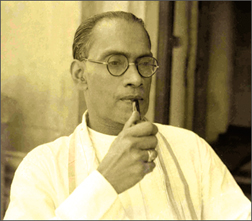|
Political allegiance of Sri Lankan Muslims:
SWRD and Muslims
A.A.M. Nizam
The Muslim community in Sri Lanka prior to the formation of the
people’s government of Prime Minister S.W.R.D. Bandaranaike in 1956 was
more or less a community of serfdom depending entirely on the handouts
from the rich traders, landowners in the agricultural areas, rich
families in the fishing areas or from the owners of large herds of
animal husbandry. An ordinary Muslim was voiceless and they had to
dutifully oblige the master if they were to stay on their vocation and
sustain their families. Due to these pathetic slavish status Muslims
were forced to support and vote for the UNP of the elites, as dictated
by their masters at times of election.
 |
|
S.W.R.D.
Bandaranaike |
Official statistics showed that a mere 3,812 elite Anglophile
urbanites of the then population of 7.5 million enjoyed more than half
of the country’s income. In such a sad situation, it became imperative
for a group of patriotic intelligentsia to meet at Madampe and adopt a
set of resolutions aimed at changing the course of the Government and
ushering in real freedom to the oppressed masses and to safeguard the
national values of the country and the independence of the people. The
outright rejection of these resolutions by the UNP Government led
S.W.R.D. Bandaranaike to resign his ministerial portfolio and crossover
to the Opposition on the Budget Day in 1951 with D.A. Rajapaksa, father
of President Mahinda Rajapaksa heroically taking the lead to follow him.
Later, four other UNP MPs and two independent MPs joined the duo.
Subsequently after much discussion among the patriotic
intelligentsia, a decision was taken to form a new party to emancipate
the oppressed masses, to strengthen racial amity and national harmony,
to confer prime place to national values and liberate the nation from
shackles of imperialist bondage.
Formation of party
A notice calling for the formation of this party on September 2, 1951
was issued with the signatures of 44 eminent personalities of that time,
which included persons of the all religions and all races. Among the 44
signatories were five Muslims and three Tamils. The Muslim signatories
were Dr. Badiudeen Mahmoud, A.T. Kareem, A.M. Marker, C.A.S. Marikkar
and A.C. Marikkar.
Over 10,000 persons, a massive crowd at that time, heeded this call
and converged at the Town Hall premises for the formation of the new
Party. At this convention the naming of the new party as the Sri Lanka
Freedom Party was proposed by H. Sri Nissanka and it was seconded by Dr.
Badi-ud-din Mahmoud. The convention elected S.W.R.D. Bandaranaike as the
President, Bernard Aluvihare, Dr. Badiuddin Mahmoud and S. Thangarajah
as Co-Secretaries and George R. de Silva as the Treasurer of the SLFP.
Education for the children of the poor Muslims at that time was
mainly confined to the schools known as Government Tamil Schools most of
which except in main towns had classes only upto fifth or eight
Standard.
While the rich Muslims, whose children were educated in leading
schools in Colombo and other places, resented the children of their
servants acquiring higher education, the teachers in the so-called
Government Tamil Schools.
 |
|
The SLFP Governments recognized the
contribution of the Muslims in all spheres. File photo |
They overwhelmingly discouraged these poor students pursuing even
basic education. Elders relate that most of these teachers used to tell
the students that as invariably they will be going to work in shops (or
get involved in other labour related works) it would be sufficient if
they learn to write something, read a few line. Even the far and few
Muslim teachers, who belonged to the rich families and served in these
schools held similar views and possessed the same attitude. The mosques
were also managed by the rich families in the relevant areas.
Major change
The first major change made by the first purely Sri Lankan oriented
Government of 1956 as opposed to the proxy-British UNP Governments for
the emancipation of Muslims in Sri Lanka was to make a complete change
of the teaching staff in schools where majority were Muslims. These
schools were named as Muslim Schools and Muslim youth who possessed a
minimum qualification of having passed SSC were appointed as teachers to
these schools, disregarding their age requirement.
There was an acute shortage of Muslim youth with SSC passed
qualifications at that time and it is said by many that in 1958, 1959
and early 60s Muslim youth got their teaching appointments, even without
submitting formal applications, along with their SSC passes and even
before attaining the required minimum age of 18.
Although ethnic based schools should not be encouraged and all
children of an area should have the right to receive education in the
school of that particular area, the establishment of Muslim Schools was
a need of the era to make a mass educational revolution in the Muslim
community. To be continued
|



